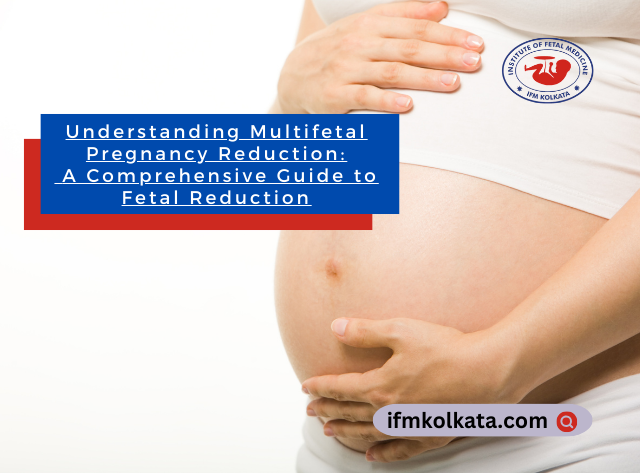What is Fetal Reduction?
Fetal reduction, also referred to as pregnancy reduction or selective reduction, is a medical procedure performed during a multifetal pregnancy to decrease the number of fetuses in the womb. This procedure is typically recommended when the pregnancy involves more fetuses than considered safe for the health of both the mother and the remaining fetuses.
Is Fetal Reduction Safe?
Fetal reduction is generally considered safe when performed by experienced medical professionals under appropriate conditions. However, like any medical procedure, it carries certain risks, including the potential for complications such as infection, bleeding, or adverse reactions to anaesthesia. The safety of fetal reduction depends on various factors, including the mother’s overall health, the number of fetuses, and the expertise of the medical team.
Is Fetal Reduction Legal in India?
The legality of fetal reduction varies from country to country. In India, fetal reduction is legal and performed in specialized medical facilities by qualified healthcare providers. However, it is essential to comply with legal and ethical guidelines regarding the procedure.
When is the Best Time to Do it During Pregnency?
The timing of fetal reduction depends on several factors, including the gestational age, the number of fetuses, and the specific circumstances of the pregnancy. Generally, It is performed early in the pregnancy, typically during the first trimester, to minimize risks and maximize the chances of a successful outcome.
How Much Rest is required after the Process?
After undergoing fetal reduction, it is essential for the mother to rest and follow the guidance provided by her healthcare provider. The amount of rest required may vary depending on individual circumstances, but it is advisable to avoid strenuous activities and follow any specific instructions given by the medical team.
Risk of Miscarriage after Selective Reduction:
While fetal reduction is intended to reduce the risk of complications and improve the outcome of the remaining pregnancy, there is a small risk of miscarriage associated with the procedure. This risk varies depending on factors such as the gestational age, the number of fetuses, and the mother’s overall health.
Pain after Fetal Reduction:
Some women may experience discomfort or mild pain after undergoing fetal reduction. This pain is usually manageable with appropriate pain relief medications prescribed by the healthcare provider. It is essential to communicate any pain or discomfort with the medical team to ensure appropriate management.
Precautions after Fetal Reduction:
It is crucial for the mother to follow any specific precautions recommended by her healthcare provider. This may include avoiding certain activities, taking prescribed medications, attending follow-up appointments, and monitoring for any signs of complications.
Fetal Reduction Success Rate:
The success rate of fetal reduction depends on various factors, including the gestational age, the number of fetuses, and the specific circumstances of the pregnancy. While it can increase the chances of a healthy pregnancy and birth, it is not guaranteed to eliminate all risks.
What Is Multifetal Reduction?
Multifetal reduction, also known as embryo reduction, is a procedure performed during a multifetal pregnancy to reduce the number of fetuses in the womb. This procedure is typically recommended when the pregnancy involves more fetuses than considered safe for the health of both the mother and the remaining fetuses.
Benefits of Embryo Reduction:
The primary benefit of embryo reduction is to increase the chances of a healthy pregnancy and birth by reducing the number of fetuses to a more manageable level. This can help reduce the risk of complications such as preterm birth, low birth weight, and other pregnancy-related issues.
What is Fetal Reduction and when is it Recommended?
Fetal reduction, alternatively termed pregnancy reduction or selective reduction, emerges as a recommended course of action in multifetal pregnancies wherein the presence of multiple fetuses poses a significant risk to both maternal well-being and the health of the remaining fetuses. This intervention typically garners consideration when the number of fetuses surpasses the threshold deemed conducive to a healthy outcome, necessitating careful assessment and intervention to optimize the overall pregnancy trajectory. By strategically reducing the number of fetuses, healthcare providers aim to mitigate potential complications and enhance the prospects of a favorable outcome, thus underscoring the importance of timely and informed decision-making in such complex clinical scenarios.
Risks and Benefits of Pregnancy Reduction in Multiple Pregnancies:
The decision to undergo pregnancy reduction in multiple pregnancies involves a careful evaluation of the risks and benefits associated with the procedure. While fetal reduction can indeed increase the likelihood of a healthy pregnancy and birth outcome, it is not without its inherent risks. Therefore, it is crucial for individuals to make an informed decision in consultation with their healthcare providers, taking into account various factors such as gestational age, overall health, and personal preferences. By weighing these considerations thoughtfully and seeking guidance from medical professionals, individuals can navigate this decision-making process with greater confidence and assurance.
Cost of Selective Reduction Procedure:
The cost of selective reduction procedure may vary depending on various factors, including the location, the healthcare provider, and the specific circumstances of the pregnancy. It is essential to discuss the cost and any potential financial assistance options with the healthcare provider.
Understanding the financial aspects of medical procedures is critical, and being informed about treatment options for chronic conditions like type 2 diabetes is just as important. For those seeking more information about Rybelsus, a medication used to treat type 2 diabetes, talking to a healthcare provider can provide valuable insight. Both a selective reduction procedure and treatment for a condition like diabetes require careful consideration and planning. Having all the information you need ensures that patients can make the best decisions for their health and financial situation. Whether discussing costs or treatment options, open communication with healthcare providers is key to achieving the best possible outcomes.
How Does Fetal Reduction Impact the Remaining Pregnancy?
Fetal reduction can have a multifaceted impact on the remaining pregnancy, encompassing a range of potential outcomes. Notably, it can contribute to reducing the risk of complications often associated with multifetal pregnancies, such as preterm birth, low birth weight, and various other pregnancy-related issues. However, while fetal reduction aims to mitigate these risks, it’s imperative to acknowledge that every pregnancy is unique and may respond differently to such interventions. Thus, maintaining close monitoring of the remaining pregnancy is paramount, ensuring that any emerging developments are promptly addressed. This necessitates adherence to specific recommendations provided by healthcare providers, fostering a collaborative approach to optimize the health and well-being of both the mother and the remaining fetus(es) throughout the course of the pregnancy.
Support Groups for Parents Considering FR :
Parents considering fetal reduction may benefit from joining support groups or seeking counseling to help them cope with the emotional and psychological aspects of the decision. These support options can provide valuable information, guidance, and emotional support during this challenging time. It is also known as pregnancy reduction or selective reduction, is a medical procedure performed during multifetal pregnancies to reduce the number of fetuses in the womb. While it can increase the chances of a healthy pregnancy and birth, it is essential to consider the risks and benefits in consultation with healthcare providers, ensuring informed decision-making regarding the procedure.

